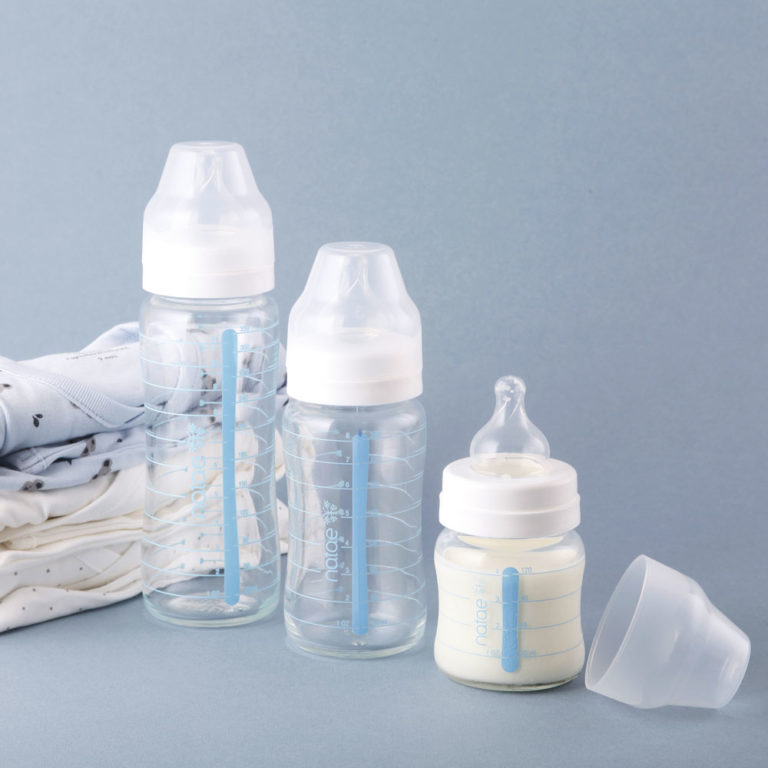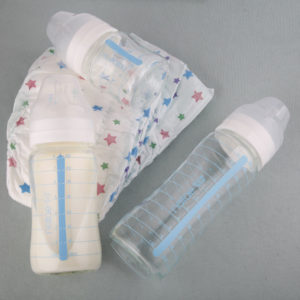
Breastfeeding is a very personal and exclusive experience for the mother and child. The switch to bottle-feeding means Dad and the rest of the family can share this time with baby too. Which means mum can take some time for herself.
You can choose between glass or plastic options for baby’s bottle. Although plastic bottles are less expensive, until just a few years ago, they contained chemical substances, such as BPA (bisphenol A) that are now banned; all bottles must comply with the requirements of standard EN14350. This standard must be indicated on all bottle packaging. Glass bottles remain the safest option because glass is made from sand and contains no chemical substances. It is recyclable and easy to wash; it is the reference in terms of food safety. In 2020, 67% of mums were more attentive to the origin and place of manufacture and 60% to hygiene and packaging conditions, well ahead of design and price. (Source FJP – the French federation of the toy and child care industry).
You may also be wondering about the choice of teat, because there are two kinds: rubber or silicone. Rubber is a noble and natural material that comes from the rubber tree. Under certain climatic conditions, this tree secretes a plant substance called latex, which is used to produce rubber. It is generally the colour of honey and its elasticity is tested under stringent conditions for the manufacture of teats.
Rubber teats offer the considerable advantage of being flexible, silky and tear-proof.
Silicone teats exists in various different shapes; silicone is highly resistant but can feel hard in the mouth. Its main advantage is that you can see if it is clean at a glance. When feeding, you will soon see if your baby has a preference for rubber or silicone teats.

Why is the cleaning of bottles and teats important? How should you clean them?
All substances left in place at a certain temperature will alter over time. Bottles and teats must be cleaned after every use to prevent the development of germs. Some say that cleaning with soapy water is sufficient, that there is no need for sterilisation… But what about the chemical composition of liquid detergents? How can you be sure that you have rinsed away all this liquid before the next feed?
There are several sterilisation options:
Sterilisation guarantees the elimination of all bacteria. After thoroughly cleaning the bottle and teat with a bottle brush, they can be sterilised. This process should be applied until baby is at least 4 months old.
“Hot” sterilisation: simple and inexpensive
The bottles are immersed in a pan of water and boiled for 20 minutes; the teats are added for the last 5 minutes. Bottles and teats are left to cool before removing them from the water and placing them in a clean, dry and sheltered place to preserve the hygiene conditions. You can also sterilise the bottle brushes, which should not be left damp by the sink.
“Cold” sterilisation
Cold sterilisation requires the purchase of chlorinated tablets or solutions specifically for sterilising bottles. According to the instructions, bottles and teats are to be immersed in the solution for 30 minutes, then drained and placed in a clean, dry and sheltered place to preserve the hygiene conditions.
“Steam” or electric sterilisation
This option means investing in a microwave steriliser. The specially designed steriliser turns water into steam. Immerse the bottles and teats; the time required obviously depends on the power of the microwave. More expensive electric appliances that perform the sterilisation in just a few minutes are also available. Make sure that your appliance is compatible with the size of your bottles.
Bottle-feeding means powdered milk…
A wide range of brands of formula milks are available from supermarkets and chemists, provided there are no oesophageal complications or allergies, in which case you should consult a paediatrician for advice on a hypoallergenic milk. Stage 1 milk is for newborns up to the age of 6 months, stage 2 milk for ages 6-12 months, then stage 3 or toddler milk after the first year.
Note: a 1-year old baby needs half a litre of milk every day.
It is important to use the measuring spoon provided with the tin of milk to avoid mistakes and to respect the doses given in the instructions. Our wide-necked bottles makes it easier to avoid spilling powder.
Start by adding the right amount of water, then the dose of powdered milk; close the bottle and shake vigorously to prevent the formation of lumps.
It is not necessary to heat the bottle: your baby can drink the milk at room temperature. However, if you decide to warm it, you must determine the heating method (bottle-warmer, microwave) and, of course, always check the temperature. Drip a little milk onto the back of your hand to test the temperature.
Do not screw the neck of the bottle too tightly as this will prevent air entering and cause the teat to collapse when the baby sucks.
Time to give the bottle
Just as with breastfeeding, your baby will want feeding when they are hungry. The exact time is less important than the rhythm of the baby’s demands. Do not wake your baby because it is time for a feed: simply respond to their demands.
Although an average number of bottles per day is indicated, this is not a strict rule and may vary according to your baby’s requirements.
Most formula milk manufacturers indicate the recommended quantities along with the dose measurements on the tin. Here is a table to give you an idea of the average quantities:
| Baby’s age | Number of bottles | Dosage |
| 0 to 1 months | 7 | 90 ml |
| 2 months | 6 | 100 ml |
| 3 months | 6 | 110 ml |
| 4 months | 6 | 120 ml |
| 5 months | 4 to 5 | 150 ml |
| 6 months | 3 to 4 | 210 ml |
| 7 months | 3 | 210 ml |
| 8 months | 2 | 240 ml or + |
| 9 months | 2 | 240 ml or + |
| 10 months | 2 | 240 ml or + |
| 11 months | 2 | 240 ml or + |
| 12 months | 2 | 240 ml or + |
| 12-18 months | 1 to 2 | 250 to 500 ml |
Morning baby or evening baby?
Your baby has a kind of alarm clock in its tummy, which rings when they are hungry. Should you give the bottle at set times or when your baby cries?
There is no decisive answer and it mostly depends on you and your baby. There are no firm rules.
You can feed according to the requirements of your baby and adapt to their rhythm. During the first few weeks, you can listen to your baby’s demands – both day and night – and feed on demand.
If your own timetable does not permit this degree of flexibility, or if you prefer more stability, your baby will adapt equally well to a more regular rhythm. However, always remember that just as you might not get hungry and feel the need to eat every so many hours… neither does your baby. They might be hungrier in the morning… or in the evening… You must pay attention to their expectations and adapt your timetable accordingly.
How to give a bottle ?
Make sure it is not too hot by dripping a few drops of milk onto the back of your hand.
Present the teat filled with milk to prevent your baby from swallowing air.
Do not over-tighten the teat or it will be too much of an effort for your baby to suck: you should see bubbles in the milk when the baby drinks. Do not insist if the bottle is not finished.
Do not keep any leftover milk.
After mixing, the milk must be drunk within an hour or thrown away.
How much to give ?
Check the table showing milk volumes to be given, but remain flexible.
Healthy children know exactly how much milk they need.
Some babies are plumper than others, and need more food. Regardless of body type, it is important that your baby follows their weight chart line.
- If your baby always finishes all bottles and demands feeding more often, you should probably increase the amount of milk you give.
- Always prepare bottles in multiples of 30 (30, 60, 90 or 120ml), which corresponds to a dose of formula milk.
To increase the amount, prepare bottles with 30ml more than previously (i.e. 1 extra dose of milk). This helps to prevent dilution mistakes.
When your baby stops wanting the bottle
After 6 months, most babies drink an average of 2 bottles per day: one in the morning, one in the evening. Some babies are desperate for their morning bottle. Others find the evening bottle soothing. Start by eliminating the least favourite bottle, but do not forget that babies still need half a litre of milk per day, even after the age of 1 year old. If your baby needs and wants the bottle, you can carry on for longer. Milk is very good for them.
Let them enjoy being a baby, they will grow up soon enough!

